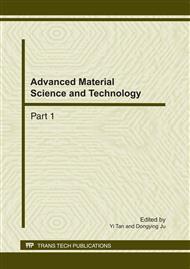p.1175
p.1179
p.1185
p.1189
p.1193
p.1197
p.1201
p.1205
p.1209
Effect of Negative Pulse Voltage on the Microstructure and Corrosion Resistance of Microarc Oxidation Film of A356 Aluminum Alloy
Abstract:
The effect of negative pulse voltage on the microstructure and corrosion resistance of microarc oxidation film of A356 aluminum alloy treated by microarc technique was investigated by SEM, coating thickness gauge and electrochemical workstation etc. The results show the negative pulse voltage greatly influences the microstructure and corrosion resistance of microarc oxidation film by its electrode reaction. The film thickness increases while the size of pore and roughness of the film surface decreases initially and then increases with negative pulse voltage increasing. The microarc oxidation treatment considerably improved corrosion resistance, and the highest corrosion potential was -1.16V, which was 0.38V higher than that of substrate, and the corrosion current was lower than that of substrate about three orders of magnitude.
Info:
Periodical:
Pages:
1193-1196
Citation:
Online since:
February 2011
Authors:
Price:
Сopyright:
© 2011 Trans Tech Publications Ltd. All Rights Reserved
Share:
Citation:


